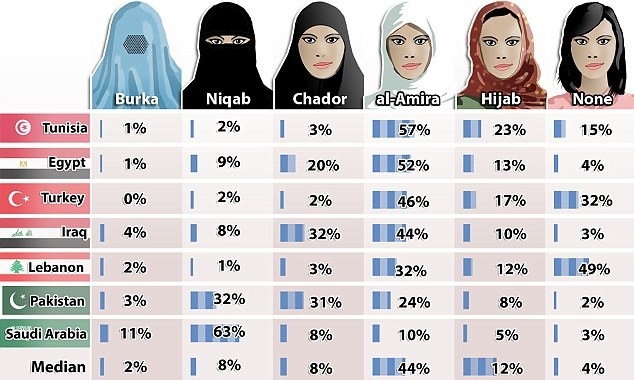


01/10/2014
Across the Islamic world, not every single Muslim believes that women should be entirely shrouded in identity-erasing tents — who knew? However the usual knuckle-dragging suspects have the opinions one might expect.
Pew Research has repackaged some polling results from the University of Michigan which surveyed seven majority Muslim countries about the attitudes of how women should appear in public. The fine points of difference between the various styles of headgear are curious, where there is varying opinion about very similar items. In particular, the chador, al-amira and hijab seem nearly identical to infidel eyes, but have divergent levels of approval among the persnickety expert misogynists.


The chart at right shows the percentage of respondents who think women themselves should decide what they should wear, and it is indicative of women’s lower value throughout the Ummah. Only two countries have a majority who think women should pick their own clothing.
Curiously, Saudi Arabia is one of the most repressive countries in a tough field, yet 47 percent there believe women should be allowed to self-dress. Perhaps they imagine the choice ranges between a black niqab (essentially a tent with eye slits) and a grey one.
Meanwhile, there is some good news to report on the burqa front: in early January, a French court upheld the nation’s ban on face coverings in public. The French have been slowly moving forward with the policy, despite noisy complaints of islamophobia and riots over burqa ban enforcement in Trappes and Marseille.
On the subject of masks in public places, scholar Daniel Pipes has kept a running blog item since 1998 listing the use of burqas as disguises in crimes and terror attacks, including 170 cases in Jordan over two years time and many instances in the west. In most instances, the burqa wearers are men of evil intent, not oppressed Muslim women.
It’s crazy to allow masked people to wander the streets of western societies. Even if they aren’t up to no good, the presence of such an alien tribe is an affront to the openness we value. Burqas are an emphatic expression of Islamic supremacism, a statement that they came to conquer, not assimilate.
Why do we admit such a hostile group as immigrants?

How people in Muslim countries prefer women to dress in public, Pew Research, January 8, 2014
An important issue in the Muslim world is how women should dress in public. A recent survey from the University of Michigan’s Institute for Social Research conducted in seven Muslim-majority countries (Tunisia, Egypt, Iraq, Lebanon, Pakistan, Saudi Arabia and Turkey), finds that most people prefer that a woman completely cover her hair, but not necessarily her face. Only in Turkey and Lebanon do more than one-in-four think it is appropriate for a woman to not cover her head at all in public.
The survey treated the question of women’s dress as a visual preference. Each respondent was given a card depicting six styles of women’s headdress and asked to choose the woman most appropriately outfitted for a public place. Although no labels were included on the card, the styles ranged from a fully-hooded burqa (woman #1) and niqab (#2) to the less conservative hijab (women #4 and #5). There was also the option of a woman wearing no head covering of any type.
Overall, most respondents say woman #4, whose hair and ears are completely covered by a white hijab, is the most appropriately dressed for public. This includes 57% in Tunisia, 52% in Egypt, 46% in Turkey and 44% in Iraq. In Iraq and Egypt, woman #3, whose hair and ears are covered by a more conservative black hijab, is the second most popular choice.
In Pakistan, there is an even split (31% vs. 32%) between woman #3 and woman #2, who is wearing a niqab that exposes only her eyes, while nearly a quarter (24%) choose woman #4. In Saudi Arabia, a 63%-majority prefer woman #2, while an additional 11% say that the burqa worn by woman #1 is the most appropriate style of public dress for women.
In several countries, substantial minorities say it is acceptable for a woman to not cover her hair in public. Roughly a third (32%) of Turks take this view, as do 15% of Tunisians. Nearly half (49%) in Lebanon also agree that it is acceptable for a woman to appear in public without a head covering, although this may partly reflect the fact that the sample in Lebanon was 27% Christian. Demographic information, including results by gender, were not included in the public release of this survey.
Even as publics in many of the surveyed countries express a clear preference for women to dress conservatively, many also say women should be able to decide for themselves what to wear. This attitude is most prevalent in Tunisia (56%), Turkey (52%) and Lebanon (49%) — all countries where substantial percentages are open to women not covering their heads in public. But nearly as many in Saudi Arabia (47%) also say a women should be free to choose how she dresses. Smaller, but sizable percentages agree in Iraq (27%), Pakistan (22%) and Egypt (14%). What the survey leaves unanswered is whether respondents think social or cultural norms will guide women in their choice to wear more conservative or less conservative attire in public.